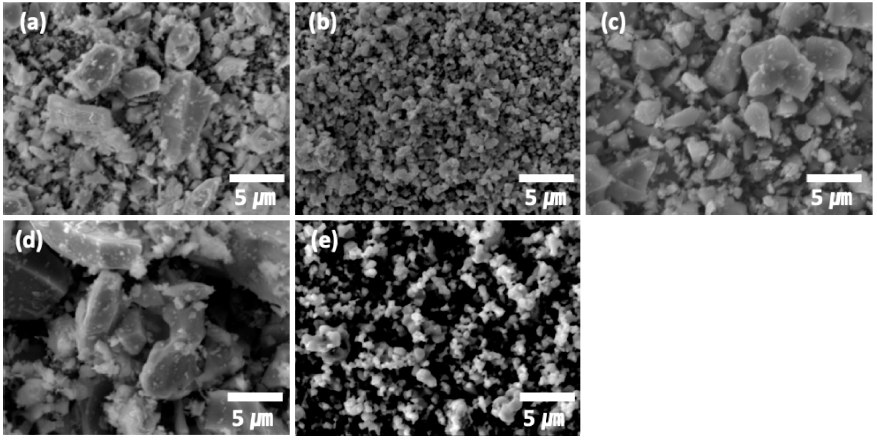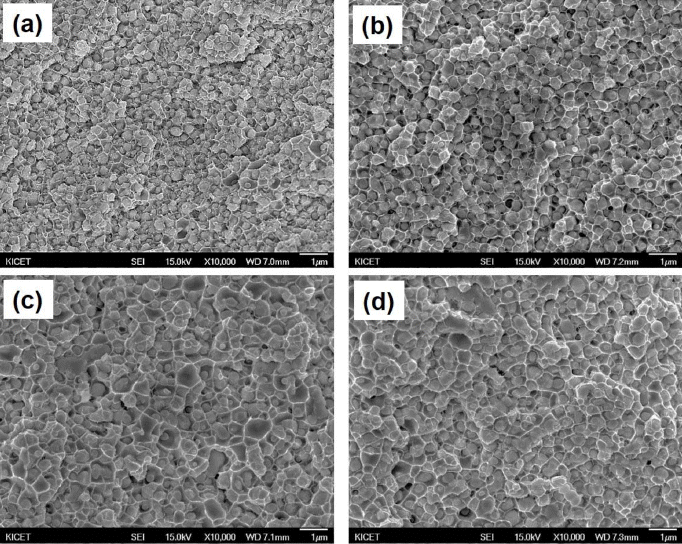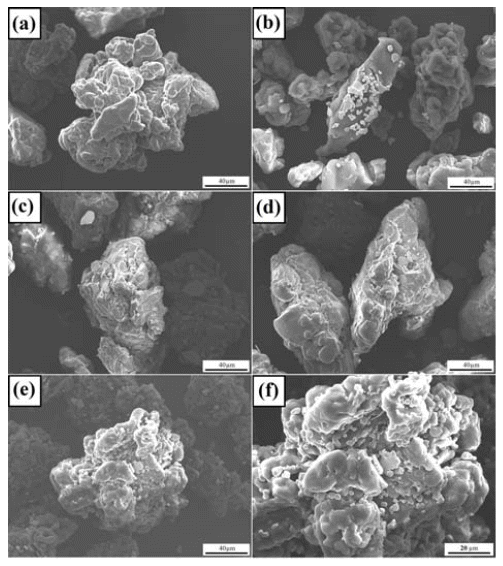Search
- Page Path
- HOME > Search
- [Korean]
- Preparation and Refinement Behavior of (Hf-Ti-Ta-Zr-Nb)C High-Entropy Carbide Powders by Ultra High Energy Ball Milling Process
- Junwoo Song, Junhee Han, Song-Yi Kim, Jinwoo Seok, Hyoseop Kim
- J Powder Mater. 2022;29(1):34-40. Published online February 1, 2022
- DOI: https://doi.org/10.4150/KPMI.2022.29.1.34

- 879 View
- 3 Download
- 1 Citations
-
 Abstract
Abstract
 PDF
PDF Recently, high-entropy carbides have attracted considerable attention owing to their excellent physical and chemical properties such as high hardness, fracture toughness, and conductivity. However, as an emerging class of novel materials, the synthesis methods, performance, and applications of high-entropy carbides have ample scope for further development. In this study, equiatomic (Hf-Ti-Ta-Zr-Nb)C high-entropy carbide powders have been prepared by an ultrahigh- energy ball-milling (UHEBM) process with different milling times (1, 5, 15, 30, and 60 min). Further, their refinement behavior and high-entropy synthesis potential have been investigated. With an increase in the milling time, the particle size rapidly reduces (under sub-micrometer size) and homogeneous mixing of the prepared powder is observed. The distortions in the crystal lattice, which occur as a result of the refinement process and the multicomponent effect, are found to improve the sintering, thereby notably enhancing the formation of a single-phase solid solution (high-entropy). Herein, we present a procedure for the bulk synthesis of highly pure, dense, and uniform FCC single-phase (
Fm3m crystal structure) (Hf-Ti-Ta-Zr-Nb)C high-entropy carbide using a milling time of 60 min and a sintering temperature of 1,600°C.-
Citations
Citations to this article as recorded by- Controlling Particle Size of Recycled Copper Oxide Powder for Copper Thermite Welding Characteristics
Hansung Lee, Minsu Kim, Byungmin Ahn
journal of Korean Powder Metallurgy Institute.2023; 30(4): 332. CrossRef
- Controlling Particle Size of Recycled Copper Oxide Powder for Copper Thermite Welding Characteristics
- [Korean]
- Characteristics of WO3-CuO Powder Mixture Prepared by High-Energy Ball Milling in a Bead Mill for the Synthesis of W-Cu Nanocomposite Powder
- Hae-Ryong Park, Sung-Soo Ryu
- J Korean Powder Metall Inst. 2017;24(5):406-413. Published online October 1, 2017
- DOI: https://doi.org/10.4150/KPMI.2017.24.5.406

- 576 View
- 4 Download
- 1 Citations
-
 Abstract
Abstract
 PDF
PDF A Nanosized WO3 and CuO powder mixture is prepared using novel high-energy ball milling in a bead mill to obtain a W-Cu nanocomposite powder, and the effect of milling time on the structural characteristics of WO3-CuO powder mixtures is investigated. The results show that the ball-milled WO3-CuO powder mixture reaches at steady state after 10 h milling, characterized by the uniform and narrow particle size distribution with primary crystalline sizes below 50 nm, a specific surface area of 37 m2/g, and powder mean particle size (D50) of 0.57 μm. The WO3-CuO powder mixtures milled for 10 h are heat-treated at different temperatures in H2 atmosphere to produce W-Cu powder. The XRD results shows that both the WO3 and CuO phases can be reduced to W and Cu phases at temperatures over 700°C. The reduced W-Cu nanocomposite powder exhibits excellent sinterability, and the ultrafine W-Cu composite can be obtained by the Cu liquid phase sintering process.
-
Citations
Citations to this article as recorded by- Morphological Characteristics of W/Cu Composite Nanoparticles with Complex Phase Structure Synthesized via Reactive Radio Frequency (RF) Thermal Plasma
Chulwoong Han, Song-Yi Kim, Soobin Kim, Ji-Woon Lee
Metals.2024; 14(9): 1070. CrossRef
- Morphological Characteristics of W/Cu Composite Nanoparticles with Complex Phase Structure Synthesized via Reactive Radio Frequency (RF) Thermal Plasma
- [English]
- Synthesis of Carbonyl Iron-reinforced Polystyrene by High Energy Ball Milling
- Hong-Hai Nguyen, Minh-Thuyet Nguyen, Won Joo Kim, Jin-Chun Kim, Young-Soo Kim, Young-Hyuk Kim, Olga B. Nazarenko
- J Korean Powder Metall Inst. 2016;23(4):276-281. Published online August 1, 2016
- DOI: https://doi.org/10.4150/KPMI.2016.23.4.276

- 673 View
- 5 Download
- 1 Citations
-
 Abstract
Abstract
 PDF
PDF Carbonyl iron (CI) is successfully incorporated as an additive into a polystyrene (PS) matrix via a highenergy ball milling method, under an n-hexane medium with volume fractions between 1% and 5% for electromagnetic interference shielding applications by the combination of magnetic CI and an insulating PS matrix. The morphology and the dispersion of CI are investigated by field emission scanning electron microscopy, which indicates a uniform distribution of CI in the PS matrix after 2 h of milling. The thermal behavior results indicate no significant degradation of the PS when there is a slight increase in the onset temperature with the addition of CI powder, when compared to the as-received PS pellet. After milling, there are no interactions between the CI and the PS matrix, as confirmed by Fourier transformed infrared spectroscopy. In this study, the milled CI-PS powder is extruded to make filaments, and can have potential applications in the 3-D printing industry.
-
Citations
Citations to this article as recorded by- Progress toward sustainable polymer technologies with ball-mill grinding
Antonio Rizzo, Gregory I. Peterson
Progress in Polymer Science.2024; 159: 101900. CrossRef
- Progress toward sustainable polymer technologies with ball-mill grinding
- [English]
- Spark Plasma Sintering of Stainless Steel Powders Fabricated by High Energy Ball Milling
- Si Young Chang, Sung-Tag Oh, Myung-Jin Suk, Chan Seok Hong
- J Korean Powder Metall Inst. 2014;21(2):97-101. Published online April 1, 2014
- DOI: https://doi.org/10.4150/KPMI.2014.21.2.97

- 544 View
- 3 Download
- 1 Citations
-
 Abstract
Abstract
 PDF
PDF The 304 stainless steel powders were prepared by high energy ball milling and subsequently sintered by spark plasma sintering, and the microstructural characteristics and micro-hardness were investigated. The initial size of the irregular shaped 304 stainless steel powders was approximately 42 μm. After high energy ball milling at 800 rpm for 5h, the powders became spherical with a size of approximately 2 μm, and without formation of reaction compounds. From TEM analysis, it was confirmed that the as-milled powders consisted of the aggregates of the nano-sized particles. As the sintering temperature increased from 1073K to 1573K, the relative density and micro-hardness of sintered sample increased. The sample sintered at 1573K showed the highest relative density of approximately 95% and a micro-hardness of 550 Hv.
-
Citations
Citations to this article as recorded by- Investigating molybdenum’s sulphur scavenging ability for MoS2 formation in preventing pitting corrosion of stainless steels
Kai Xiang Kuah, Daniel J. Blackwood
npj Materials Degradation.2023;[Epub] CrossRef
- Investigating molybdenum’s sulphur scavenging ability for MoS2 formation in preventing pitting corrosion of stainless steels
TOP
 kpmi
kpmi


 First
First Prev
Prev


